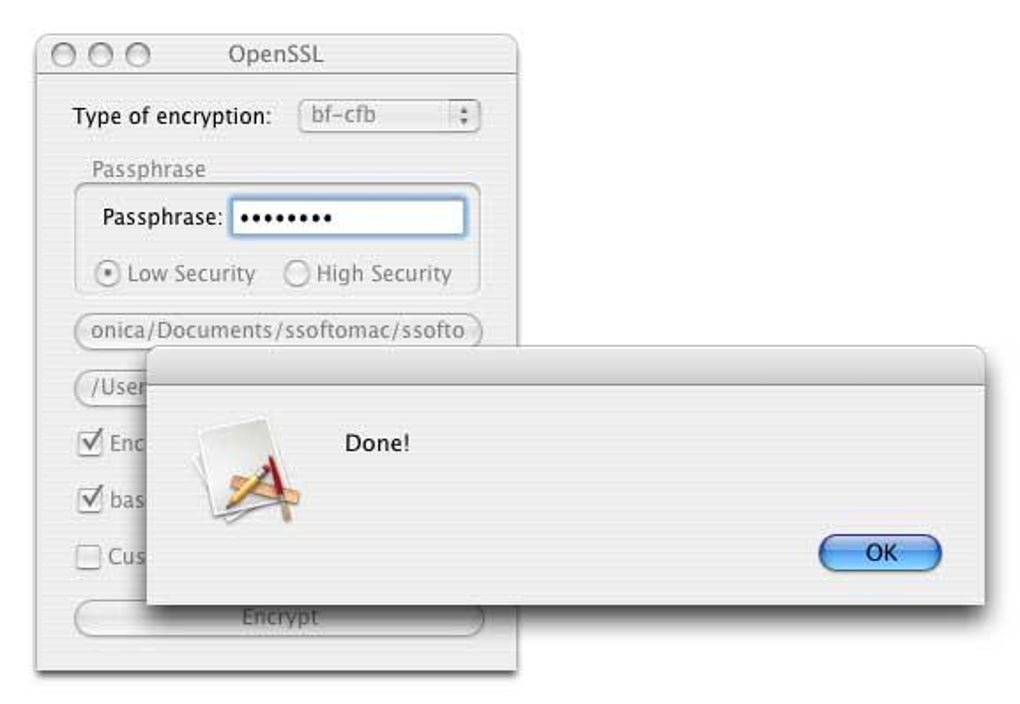
- Openssl for mac os x for mac os x#
- Openssl for mac os x password#
- Openssl for mac os x download#
- Openssl for mac os x mac#
I./modes -I./asn1 -I./evp -I././include -DOPENSSL_THREADS -D_REENTRANT -DDSO_DLFCN -DHAVE_DLFCN_H -arch i386 -O3 -fomit-frame-pointer -DL_ENDIAN -DOPENSSL_BN_ASM_PART_WORDS -DOPENSSL_IA32_SSE2 -DOPENSSL_BN_ASM_MONT -DOPENSSL_BN_ASM_GF2m -DSHA1_ASM -DSHA256_ASM -DSHA512_ASM -DMD5_ASM -DRMD160_ASM -DAES_ASM -DVPAES_ASM -DWHIRLPOOL_ASM -DGHASH_ASM -c -o a_octet.o a_octet.cĬc -I. I./modes -I./asn1 -I./evp -I././include -DOPENSSL_THREADS -D_REENTRANT -DDSO_DLFCN -DHAVE_DLFCN_H -arch i386 -O3 -fomit-frame-pointer -DL_ENDIAN -DOPENSSL_BN_ASM_PART_WORDS -DOPENSSL_IA32_SSE2 -DOPENSSL_BN_ASM_MONT -DOPENSSL_BN_ASM_GF2m -DSHA1_ASM -DSHA256_ASM -DSHA512_ASM -DMD5_ASM -DRMD160_ASM -DAES_ASM -DVPAES_ASM -DWHIRLPOOL_ASM -DGHASH_ASM -c -o a_int.o a_int.cĬc -I. Just to convince you I am using your script, this is the tail for the beginning of the logs you might be able to recognize:Ĭc -I.
Openssl for mac os x mac#
Yet the lib directory just has the two mac files, where have the libcrypto_iOS.a” and “libssl_iOS.a" files finished? /libcrypto.a(v3_addr.o) has no symbolsĪnyway now the program terminated without errors, even if not writing Done this is the output:īuilding openssl-1.0.1h for iPhoneOS 7.1 armv7īuilding openssl-1.0.1h for iPhoneOS 7.1 armv7sīuilding openssl-1.0.1h for iPhoneOS 7.1 arm64īuilding openssl-1.0.1h for iPhoneSimulator 7.1 x86_64 Applications/Xcode.app/Contents/Developer/Toolchains/XcodeDefault.xctoolchain/usr/bin/ranlib: file. /libcrypto.a(evp_fips.o) has no symbols /libcrypto.a(rand_os2.o) has no symbols /libcrypto.a(rand_win.o) has no symbols

/libcrypto.a(ecp_nistputil.o) has no symbols /libcrypto.a(ecp_nistp521.o) has no symbols

At any rate I keep getting errors, seemingly starting from: I added a symbolic link to the actual SDK from the file it searched.
Openssl for mac os x download#
# Download openssl and place the tarball next to this scriptĮcho "usage: $0 "Įcho "Building $-iOS-x86_64/lib/libssl.a " \
Openssl for mac os x password#
When you encrypt the file initially, it will prompt you to set a password to access the file and decrypt it again in the future – do not forget the password because triple DES encryption is incredibly powerful and you’ll likely lose the file’s content forever without the password.# This script builds the iOS and Mac openSSL libraries Omit the -out * stuff if you want it to pipe data out on STDOUT. Remove the -in * stuff if you want to pipe data into it (e.g. I have noticed weird effects on OS X (it eats the file). Openssl des3 -d -salt -in encryptedfile.txt -out normalfile.txtīe sure to heed this important advice so you don’t overwrite and lose files:ĭo not specify the same file as input and output on encryption.

Openssl des3 -salt -in file.txt -out encryptedfile.txt You’ll need to use the OpenSSL technology via the command line for this to work.Ĭommand syntax for encrypting and decrypting with openssl is as follows: This is a pretty simple way to encrypt a single file so that it is nearly impossible for others to read, and it will require a password to access again. Note: For a detailed article on encrypting and decrypting files with OpenSSL, click here otherwise you can follow the quick guide below: Encrypt a file using OpenSSL via the Command Line
Openssl for mac os x for mac os x#
This tip is repeated from a reader provided snippet, but slightly modified and annotated to better accommodate for Mac OS X users: A reader named Jim posted in the comments a tip about using OpenSSL that I have used a bunch since then, and I think others will find this useful as well. We got several good responses but one in particular has really stuck with me. A few months ago a question was posed to our readers about encrypting or password protecting a text file.


 0 kommentar(er)
0 kommentar(er)
